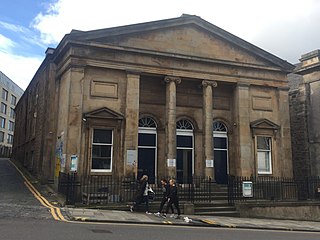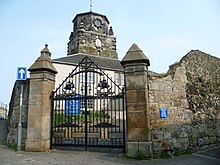
Fife is a council area, historic county, registration county and lieutenancy area of Scotland. It is situated between the Firth of Tay and the Firth of Forth, with inland boundaries with Perth and Kinross and Clackmannanshire. By custom it is widely held to have been one of the major Pictish kingdoms, known as Fib, and is still commonly known as the Kingdom of Fife within Scotland. A person from Fife is known as a Fifer. In older documents the county was very occasionally known by the anglicisation Fifeshire.

Kirkcaldy is a town and former royal burgh in Fife, on the east coast of Scotland. It is about 11.6 miles (19 km) north of Edinburgh and 27.6 miles (44 km) south-southwest of Dundee. The town had a recorded population of 49,460 in 2011, making it Fife's second-largest settlement and the 12th most populous settlement in Scotland.
Cupar is a town, former royal burgh and parish in Fife, Scotland. It lies between Dundee and Glenrothes. According to a 2011 population estimate, Cupar had a population around 9,000, making it the ninth-largest settlement in Fife, and the civil parish a population of 11,183. It is the historic county town of Fife, although the council now sits at Glenrothes.

Crail ; Scottish Gaelic: Cathair Aile) is a former royal burgh, parish and community council area in the East Neuk of Fife, Scotland.

Kinghorn is a town and parish in Fife, Scotland. A seaside resort with two beaches, Kinghorn Beach and Pettycur Bay, plus a fishing port, it stands on the north shore of the Firth of Forth, opposite Edinburgh. According to the 2008 population estimate, the town has a population of 2,930.

Culross (/ˈkurəs/) is a village and former royal burgh, and parish, in Fife, Scotland.

Inverkeithing is a coastal town and parish in Fife, Scotland, on the Firth of Forth, 9½ miles north west of Edinburgh city centre.

Burntisland is a former royal burgh and parish in Fife, Scotland, on the northern shore of the Firth of Forth. According to the 2011 census, the town has a population of 6,269. It was previously known as Wester Kinghorn or Little Kinghorn.

Methil is an eastern coastal town in Scotland. It was first recorded as "Methkil" in 1207, and belonged to the Bishop of St Andrews. Two Bronze Age cemeteries have been discovered which date the settlement as over 8,000 years old. Famous for its High Street that used to have the most pubs per mile in Scotland, it was part of its own barony in 1614 and also part of the former burgh of Buckhaven and Methil. This burgh existed between 1891 and 1975. It is situated within a continuous urban area described as Levenmouth.

Ceres is a village in Fife, Scotland, located in a small glen approximately 2 miles (3 km) over the Ceres Moor from Cupar and 7 mi (11 km) from St Andrews. The former parish of that name included the settlements of Baldinnie, Chance Inn, Craigrothie, Pitscottie and Tarvit Mill.

Auchtermuchty is a town in Fife, Scotland. It is beside Pitlour Hill and 9 miles (14 km) north of Glenrothes.

Anstruther is a small coastal resort town in Fife, Scotland, situated on the north-shore of the Firth of Forth and 9 mi (14 km) south-southeast of St Andrews. The town comprises two settlements, Anstruther Easter and Anstruther Wester, which are divided by a stream, the Dreel Burn. With a population of 3,500, it is the largest community on the Firth of Forth's north-shore coastline known as the East Neuk. To the east, it merges with the village of Cellardyke.

Falkland, previously in the Lands of Kilgour, is a village, parish and former royal burgh in Fife, Scotland, at the foot of the Lomond Hills. According to the 2008 population estimate, it has a population of 1,180.

St Andrew's and St George's West Church serves Edinburgh's New Town, in Scotland. It is a congregation of the Church of Scotland. The parish today constitutes the whole of the First New Town of Edinburgh and a small part of the early-19th-century Second New Town of Edinburgh. The church building was completed in 1784, and is now protected as a category A listed building.

Elie and Earlsferry is a coastal town and former royal burgh in Fife, and parish, Scotland, situated within the East Neuk beside Chapel Ness on the north coast of the Firth of Forth, eight miles east of Leven. The burgh comprised the linked villages of Elie to the east and to the west Earlsferry, which were formally merged in 1930 by the Local Government (Scotland) Act 1929. To the north is the village of Kilconquhar and Kilconquhar Loch.

Kirkcaldy was a local government district in the Fife region of Scotland from 1975 to 1996. The district was named after the town of Kirkcaldy but also covered a wider area, including the Fife regional capital of Glenrothes.

Scottish renaissance painted ceilings are decorated ceilings in Scottish houses and castles built between 1540 and 1640. This is a distinctive national style, though there is common ground with similar work elsewhere, especially in France, Spain and Scandinavia. An example in England, at Wickham, Hampshire, was recorded in 1974. There are records of over 100 examples, and a much smaller number of painted ceilings survive in-situ today. Some salvaged painted beams and boards are stored by Historic Environment Scotland. The paintings at Crathes Castle, dating from 1597 and 1602 are probably the best known.

Balmerino Parish Church is a Church of Scotland parish church in Bottomcraig, Fife, Scotland. The church sits in the centre of the small village where it was built in 1811. It is situated across the road from the accompanying manse constructed in 1816.

Pittenweem Parish Church and Tolbooth Steeple is an ecclesiastical and municipal complex in the High Street, Pittenweem, Fife, Scotland. The structure, which is used as the local parish church, is a Category A listed building.

St Oran's Church was a Gaelic-speaking congregation of the Church of Scotland in Edinburgh. Originating in the early 18th-century, the congregation continued until 1948, latterly meeting at Broughton Street.




















